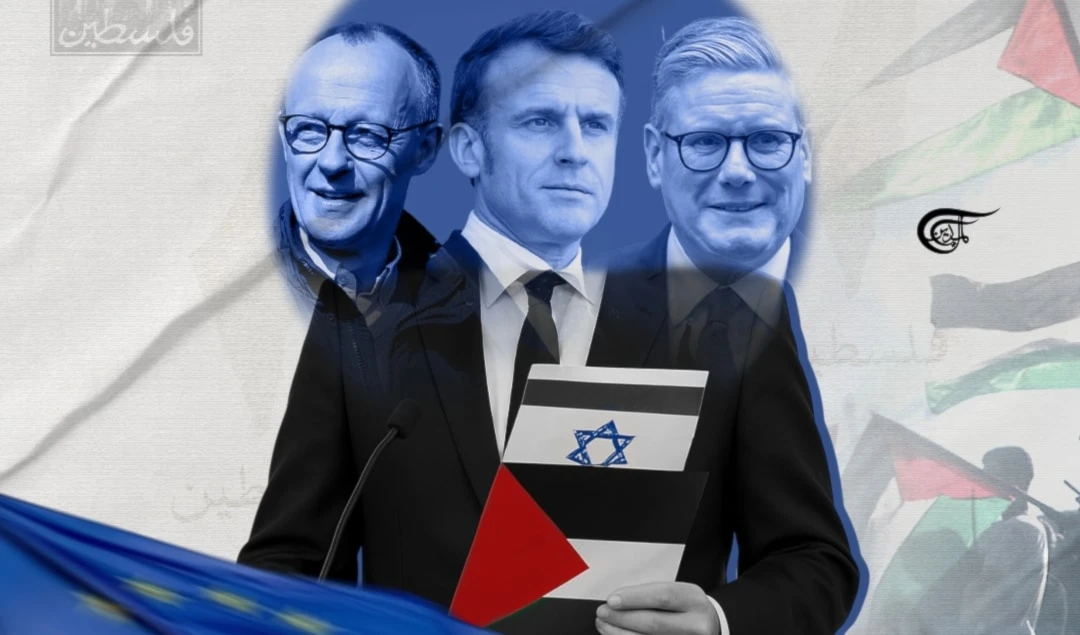How HTS' ground strategy intersected with America, 'Israel's' project in Syria
What opened up the prime chance for the complete destabilization of Syria was the years-long eroding of its own economy and military and potential productive forces inhibited by the occupation of oil fields and illegal US bases in Syria’s northeast.
-

How HTS' ground strategy intersected with America, 'Israel's' project in Syria
Immediately after Hezbollah’s post-ceasefire period marking a victory for the Resistance group, the US and "Israel" immediately activated the next step of their follow-up plan, leading to the sudden sweep through Aleppo by the Hay'at Tahrir al-Sham (HTS) counterinsurgency.
HTS is led by Muhammad al-Jolani, the former leader of the now-disbanded al-Nusra front, an adjacent leader of Daesh (ISIS) and al-Qaeda who worked closely with former Daesh head Abu Bakr al-Baghdadi. In recent years, Al-Jolani's HTS rebranded as the “lesser evil” terror group that focused on its Syria takedown, mainly targeting Iran and Hezbollah.
Al-Jolani oscillated between a turban and military fatigues and suit and tie as he navigated between his roles as a Takfiri insurgent and a suit-clad opposition figure. His rebranding came more into the spotlight in 2021 with an unprecedented PBS frontline interview. In 2022, Russia’s envoy to Syria revealed that Turkey, with Western backing, was working to downgrade HTS into a “moderate opposition” - a move done in order to shed itself of international terrorist designation while honing the US’ next focus for Syria and the post-war in Lebanon phase.
With the West perceiving itself to have exhausted Russia in Ukraine, Hezbollah against “Israel", and Iran across fronts, stalled by a reconciliatory president, inciting a counterinsurgency, terror sweep now was done within a narrow opportunity of what the US and "Israel" perceive to be a closing window. These were indeed factors that inhibited the full capacity in Syria’s supporters, yet what opened up the prime chance for the complete destabilization of Syria was the years-long eroding of its own economy and military and potential productive forces inhibited by the occupation of oil fields and illegal US bases in Syria’s northeast.
As the so-called "Syrian opposition" was pumped with funding and logistical support - directly by Turkey and thus, secondarily by the US, UK, and “Israel", the Syrian army was withered down, in need of serious rehabilitation and support. Syrian Army members reportedly received only $40 a month, thanks to years of US sanctions and the adverse effects of hybrid warfare. In 2018, Russia advised Syria that its army needed bottom-up rehabilitation, and Damascus was faced with the challenge of needing to shore up $200 billion in reconstruction nationally. As Syria struggled with these reconstructive challenges, Assad resorted to reconciliations and negotiations that put a defensive approach in the backseat - but the foundation enabling an easy collapse, mutiny, and takeover had been set, 6 years before HTS’ late November 2024 invasion.
Syria has now fallen after years of neglecting fortification in its defense and rehabilitation of its economy. The post-Astana and negotiation era was marked by concessions, attempting to placate the Gulf and facilitate easier rapprochement with these powers by rejecting Iranian offers to station around the Golan and South. Syria did not take hard steps to take back land where billions in oil wealth were stolen in the Northeast, build Syria’s crumbling and depleted military institutions and basis for economic self-sufficiency, expecting the post-Astana negotiation process and Iranian and Russian partnership to just work themselves out.
While these political solutions were slow to bring results, the opposition, well-supported and funded albeit divided, had taken advantage of the post-2020-ceasefire period. HTS used this time to consolidate its hold on Idlib and the North and increase its attacks on the Syrian Army on the ground, doubling from an average of 200 attacks in 2021 to 400 in 2022. HTS also took advantage of US sanctions on Syria in the aftermath of its disastrous February 2023 earthquake by reinforcing Washington’s aims of preventing aid from reaching “regime-held” areas, only allowing Turkish support to come through. Turkey would also benefit from the increased circulation of its currency, complementing its expanded ambitions over taking over Syria’s north, coinciding with the further collapse of Syria’s own currency.
From the onset, the HTS-led Takfiri insurgency had goals and patterns of operations not only aligned with but directly curated by “Israel” and the US. Since 2017, the targets of HTS terror bombing attacks have been Syrian government officials, Syrian scientists, Shi’ite civilians, pilgrims (while taking a page out of the American/Israeli discourse in deeming them “Iranian agents”) and, almost exclusively in later years following the HTS’ “rebranding", positions of US adversaries in Syria, whether they were from Hezbollah, the IRGC, or Russia. The US allowed ISIS to die and phase out in coordinated airstrikes as HTS, with its more localized focus, was enabled to grow.
After the escape of hundreds of Takfiri leaders from Hasakah prisons earlier this year, many of them moved South toward army positions in Daraa and Damascus. This was followed by ground gun attacks on the Syrian Army and police by Takfiri groups in these locations in the south, now being overrun by Israeli attacks.
The Zionist entity’s aerial attacks across Syria, especially on military infrastructure in major cities, have been relentless and continuous over the last two years and especially in the past few months. During the war in Lebanon, “Israel” repeatedly struck the Masnaa border crossing between Syria and Lebanon, as well as the northern Arida border crossing. Repeated bombings of crossings between Lebanon and Syria have kept the humanitarian pressure on besieged Lebanese, as well as objectives to cut supply routes to and from Lebanon.
As Takfiri groups attacked Syrian army positions from the ground, “Israel” bombed the Syrian Army from the sky, further weakening it. One of the latest targeted attacks on the Army was on a Palmyra army center, where 36 were massacred. The Israeli-Takfiri ground and air coordination is nothing new of course. It was well documented nearly a decade ago that "Israel" provided Jabhat al-Nusra (the predecessor organization to HTS) with maps and blueprints of Syrian Army positions to attack in the country’s south. They also provided them with communication devices and medical equipment, allowing Syrian refugee camps to even be set up on the border. Earlier, a UN report from 2014 confirmed the close coordination the so-called “rebels” had with "Israel".
One of their first targets was the same research centers and production facilities for the Resistance’s weapons "Israel" has struck for a while. These were carried out in coordination with the US and Zionist entity. “Israel” was long disappointed that their attacks have not “halted or neutralized” their activity, a step that would be delegated to their allies on the ground.
Beginning with Aleppo, the militants sniped and killed the director, Dr. Yervant Arslanian, and besieged the Syrian Scientific Research Center in Aleppo, the economic engine of the country and defense engine of both Syria and the Axis of Resistance.
The Takfiri opposition also attacked CERS Institute 4000 in Masyaf, the target of Israeli bombings and Mossad attacks for years. Aided by the intelligence and work "Israel" had done in attacking the facilities - among them the more recent September Masyaf raid by “Israel” that killed 18 people, HTS launched an attack via a Ukrainian drone on December 4 on the CERS institute amid its incursion into Hama - going after a site long-targeted by “Israel” after the latter admitted it was insufficient with airstrikes alone.
Their next target was Homs, just 45km away. This pivoted the territorial balance of the equation in favor of the terrorists, aimed at isolating the Lebanese Resistance via what used to be a key transfer and transport route of weapons, supplies, and logistics.
“Israel’s” goals for Homs, in softening the ground for the incoming Takfiri counterinsurgency, has been to bomb locations around that city it alleges to be harboring Hezbollah combat equipment storage and transfer sites, as well as entry and transfer points for Hezbollah units in Syria. Israeli army Arabic-language spokesman Avichay Adraee emphasized this in a Tweet the night after Hama was taken, and it is no coincidence his words come as Homs was the next target for the “rebels".
At this point, it was clear that the Syrian Army was no longer putting up a fight, due to orders of compromised generals, going against Assad’s directive, to lay down arms. The deep infiltration had consumed the ranks almost instantly. Russian airstrikes that had struck terrorist locations in the early days of the Aleppo siege had stopped, and the IRGC had no active force to mobilize alongside. Homs officially fell on Saturday, December 7, and the fall of Syria, finalized by Assad’s orders to minimize mass civilian bloodshed by ordering a peaceful transition of power, agreed upon by the conclusion of the Astana talks between Iran, Russia, and Turkey, had put the final nails in the coffin.
“Israel” also has aimed to expand its buffer zone into the Golan Heights parameters, pacifying a long-held fear of Resistance infiltration into the heights after 14 months of Hezbollah operations against sites in the occupied territory.
Syria’s post-regime change invited an incursion of Quneitra under the pretext of expanding this so-called buffer zone. Simultaneously, “Israel” struck all of Syria’s critical military sites, infrastructure, and warehouses inan attempt to wipe out any defense ability that could be transferred to Lebanon or used against the occupying entity in the future.
This was accompanied by congratulations given by Netanyahu to the “historic” fall of the “tyranny in Damascus,” a longtime American project made possible through a coordinated effort between rebel groups and "Israel".
"Without the blows you inflicted on Hezbollah and Iran, we could not free Syria," Free Syrian Army spokesperson Fahd Masri told Israeli media. "Thank you, Israel. This is an Israeli victory, our brothers and neighbors,” he said, echoing statements issued by a number of "Syrian opposition" and Free Syrian Army members to Zionist media in the last few weeks.
It’s more than obvious at this point whose goals the current unfolding in events serve. Syria’s fragile situation in the last decade mobilized Resistance factions toward a trajectory for domestic production and self-sufficiency across fields, a plan accelerated by the late IRGC Commander Hajj Qassem Soleimani.
Hezbollah already produces its own missiles and drones domestically with weapons stores unknown to “Israel". While the fall of Syria is a very dark and difficult closing of a chapter for the Axis of Resistance, the miracles of besieged Gaza and Yemen for years provide us with a lesson going forth that the trajectory for the highly adaptable Resistance factions will continue and reach new heights as events are yet to unfold.

 Julia Kassem
Julia Kassem
 10 Min Read
10 Min Read











